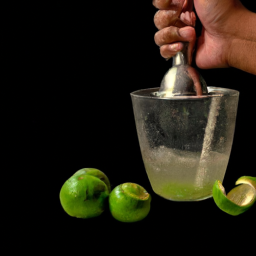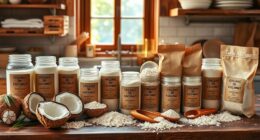For those who appreciate the wellness advantages of aloe vera juice, it’s crucial to be aware of the duration for which the product remains fresh and consumable. Knowledge of the shelf life of aloe vera juice is key to maximizing the benefits of your purchase while preventing any possible health hazards.
In this article, I will explore the various factors that affect the shelf life of aloe vera juice, including proper storage, the use of preservatives, and signs of spoilage. I will also discuss the benefits of consuming aloe vera juice and precautions to take when incorporating it into your diet.
By the end of this article, you will have a clear understanding of how long aloe vera juice is good for and how to maximize its health benefits.
Key Takeaways
- Aloe vera juice can last up to a year if stored and handled properly, but factors such as exposure to air, light, and heat can affect its shelf life.
- To extend the shelf life of aloe vera juice, it should be kept refrigerated and away from direct sunlight, and consumed within 6-8 months of opening the container. Signs of spoilage include changes in color, texture, smell, and flavor.
- Aloe vera juice has numerous health benefits, including boosting the immune system, aiding digestion, promoting skin health, reducing inflammation, and aiding in weight loss. However, it is important to start with a small amount and gradually increase dosage, as adverse effects such as diarrhea and stomach pain can occur.
- A high-quality aloe vera juice free from additives and preservatives should be chosen, as some products may contain aloin which can cause severe diarrhea. Aloe vera juice can be incorporated into the diet by mixing with other beverages or using in smoothies. More research is needed to fully understand its effects.
Understanding the Shelf Life of Aloe Vera Juice
Did you know that aloe vera juice has a relatively long shelf life of up to a year? However, this is only possible if it’s stored and handled properly.
There are several factors that can affect the shelf life of aloe vera juice, including exposure to air, light, and heat. To extend the shelf life of aloe vera juice, it should always be kept refrigerated and away from direct sunlight.
When it comes to determining the expiration date of aloe vera juice, there are some guidelines to follow. Most manufacturers will indicate the expiration date on the label of the product, but it’s important to note that this date is only an estimate.
The actual shelf life of the product can vary depending on how it’s stored and handled. As a general rule, it’s recommended to consume aloe vera juice within 6-8 months of opening the container.
With a better understanding of the shelf life factors and expiration date guidelines, it’s important to also be able to recognize when aloe vera juice has gone bad. Let’s take a closer look at some signs that indicate it’s time to dispose of your aloe vera juice.
Signs that Aloe Vera Juice Has Gone Bad
You may notice a sour smell or a change in color and texture, indicating that the aloe vera juice has spoiled. Off flavors and color changes are the most common signs that aloe vera juice has gone bad. When the juice becomes contaminated with bacteria, fungi, or other microorganisms, it can cause a chemical breakdown of the aloe vera gel, leading to unpleasant tastes and odors.
Moreover, the color of the juice may change from clear to cloudy, which is another sign of spoilage. The texture of the juice may also become slimy or thick, indicating that the gel has broken down and is no longer fresh. If you notice any of these signs, it’s best to discard the juice immediately and not consume it.
Proper storage of aloe vera juice can help prevent spoilage, and we’ll discuss this in the subsequent section.
Proper Storage of Aloe Vera Juice
To keep your aloe vera juice fresh and prevent spoilage, it’s important to store it properly. Aloe vera juice should be stored in a cool, dry place away from direct sunlight to prevent exposure to heat and light. Heat and light can cause the aloe vera juice to break down and spoil more quickly.
Additionally, it’s important to make sure that the container is tightly sealed to prevent air from getting in and oxidizing the juice. When storing aloe vera juice, there are a few tips and tricks to keep in mind. One is to avoid storing the juice in the refrigerator, as this can cause it to become too thick and difficult to drink. Instead, store it in a pantry or cupboard that is cool and dry.
Another tip is to always check the expiration date on the container and use the juice before it expires. While aloe vera juice has a relatively long shelf life, it’s important to use it before it goes bad. Using preservatives to extend shelf life can be an effective way to keep aloe vera juice fresh for longer. However, it’s important to use preservatives that are safe and effective.
In the next section, we’ll explore some of the best preservatives to use and how to incorporate them into your aloe vera juice.
Using Preservatives to Extend Shelf Life
Using preservatives can help keep aloe vera juice fresh for a longer period of time, but what are the safest and most effective options for extending its shelf life? Here are some natural alternatives and DIY options that you can try:
-
Citric acid: This natural preservative can help increase the acidity of aloe vera juice, making it more difficult for bacteria to grow. Simply add a small amount of citric acid to your juice and mix well.
-
Vitamin C: Another natural preservative, vitamin C can help prevent oxidation and spoilage. You can add powdered vitamin C to your aloe vera juice, or even blend in some fresh citrus fruits.
-
Honey: Not only does honey add a touch of sweetness to your aloe vera juice, it also has antimicrobial properties that can help keep it fresh. Use raw, organic honey for best results.
-
Refrigeration: While not a preservative per se, refrigeration is one of the best ways to extend the shelf life of aloe vera juice. Keeping it chilled can help slow down the growth of bacteria and other microorganisms.
By using these natural alternatives and DIY options, you can help ensure that your aloe vera juice stays fresh and safe to drink. But how can you tell if it’s still good? Read on to find out.
How to Tell if Aloe Vera Juice is Safe to Consume
Wondering if your aloe vera beverage is still safe to drink? Here’s how to check if it’s still fresh and healthy for consumption.
Aloe vera juice has an expiration date, just like any other consumable product. However, it’s important to note that the expiration date is not the only factor in determining the freshness of aloe vera juice.
To determine the freshness of aloe vera juice, you can start by checking its color and smell. Fresh aloe vera juice should be clear and not have a strong odor. If the juice has a cloudy appearance or a sour smell, it may have gone bad.
Another way to check the freshness is to taste a small amount. If it tastes off or bitter, it’s best to discard it.
It’s also important to store aloe vera juice properly, as exposure to sunlight and heat can cause it to spoil faster.
By following these guidelines, you can ensure that you’re consuming fresh and healthy aloe vera juice.
Consuming aloe vera juice has many benefits, including aiding in digestion and supporting a healthy immune system. Now that you know how to determine the freshness of aloe vera juice, you can enjoy all the benefits that this natural beverage has to offer.
Benefits of Consuming Aloe Vera Juice
You can reap a multitude of benefits by incorporating aloe vera juice into your daily routine, such as giving your immune system a boost and soothing digestive issues like a balm on a wound. Aloe vera juice is a great source of antioxidants, vitamins, and minerals that can help improve your overall health. The table below highlights some of the health benefits and nutritional value of aloe vera juice.
| Health Benefits | Nutritional Value |
|---|---|
| Boosts Immune System | Vitamin C |
| Soothes Digestive Issues | Vitamin B-12 |
| Helps Detoxify the Body | Calcium |
| Promotes Skin Health | Magnesium |
| Reduces Inflammation | Amino acids |
In addition to the above benefits, aloe vera juice is also known to help lower cholesterol and blood sugar levels, promote hydration, and aid in weight loss. However, it is important to note that these benefits are largely anecdotal and more research is needed to fully understand the effects of aloe vera juice on the body.
Moving forward, it is important to take precautions when consuming aloe vera juice to avoid any potential side effects.
Precautions When Consuming Aloe Vera Juice
Before incorporating aloe vera juice into your diet, it’s crucial to be aware of the potential side effects and take necessary precautions to ensure your safety. Although aloe vera juice has numerous health benefits, it can also cause adverse reactions such as diarrhea, stomach pain, and cramping. This is because aloe vera contains laxative compounds that can irritate the digestive tract.
As such, it’s recommended to start with a small amount of aloe vera juice and gradually increase the dosage over time to avoid any unpleasant side effects. Additionally, it’s important to choose high-quality aloe vera juice that is free from additives and preservatives.
Some aloe vera products may contain aloin, a yellow-brown substance found in the outer layer of aloe vera leaves that can cause severe diarrhea. Therefore, it’s crucial to read the labels carefully and opt for aloe vera juice that is certified organic and has undergone rigorous testing.
By taking these precautions, you can enjoy the benefits of consuming aloe vera juice without any adverse effects on your health. To incorporate aloe vera juice into your diet, there are various ways you can consume it such as mixing it with other juices or adding it to smoothies.
By doing so, you can reap the many benefits of aloe vera juice such as improved digestion, boosted immunity, and enhanced skin health. With the right precautions in place, aloe vera juice can be a valuable addition to your daily diet.
How to Incorporate Aloe Vera Juice into Your Diet
Now that we’ve discussed the precautions when consuming aloe vera juice, let’s talk about how to incorporate this healthful drink into your diet.
Aloe vera juice can be consumed in many ways, and one of the most popular ways is by making aloe vera smoothies. These smoothies are a great way to include aloe vera in your diet and can be made by blending aloe vera gel with your favorite fruits and vegetables. Aloe vera smoothies are not only delicious, but they also provide a host of health benefits like improved digestion and hydration.
Another way to incorporate aloe vera juice into your diet is by taking aloe vera juice shots. These shots are a quick and convenient way to get your daily dose of aloe vera. Simply pour a small amount of aloe vera juice into a shot glass and drink it straight up. You can also add a little bit of lemon or honey to make it more palatable. Aloe vera juice shots are a great way to start your day or give you a boost of energy in the afternoon.
When it comes to choosing the right aloe vera juice product, it’s important to look for a product that is made from 100% pure aloe vera gel. Avoid products that contain added sugars, preservatives, or artificial colors and flavors. Reading the labels carefully and doing a little bit of research can help you find the best aloe vera juice product for your needs.
Choosing the Right Aloe Vera Juice Product
Looking for the perfect aloe vera juice product can be like searching for a needle in a haystack, but with a little research and label-reading, you can find the purest, most natural option to nourish your body.
When choosing the right brand, it’s important to look for a product that is 100% pure and organic. This ensures that the aloe vera plant was grown without the use of harmful pesticides and herbicides, which can ultimately affect the quality of the juice.
Another important factor to consider when choosing aloe vera juice is the processing method. Some brands use heat during the extraction process, which can destroy some of the beneficial nutrients found in the plant. Cold-pressed aloe vera juice, on the other hand, is extracted without heat and maintains the full spectrum of nutrients and enzymes.
Finding organic options and cold-pressed aloe vera juice can ensure that you’re getting the most out of your aloe vera juice and reaping all the benefits it has to offer.
Frequently Asked Questions
Can I consume aloe vera juice if I am pregnant or breastfeeding?
As a pregnant or breastfeeding individual, it’s important to consider the potential risks associated with consuming aloe vera juice. While there is limited research on the topic, it’s generally recommended to err on the side of caution and avoid consuming aloe vera juice during pregnancy or while breastfeeding.
Is it safe to consume aloe vera juice if I am on medication?
I investigated and found that aloe vera juice can interact with some medications, so it’s best to consult with a healthcare provider before consuming it. Dosage recommendations vary depending on the individual’s health status and medication.
Can aloe vera juice be used topically on the skin?
Yes, aloe vera juice can be used topically on the skin for its many benefits, including skin hydration. It has been scientifically proven to soothe and moisturize the skin, making it a popular ingredient in skincare products.
Can aloe vera juice help with digestive issues?
Wow, aloe vera juice has amazing digestive benefits! I recommend taking 1-2 ounces daily for optimal results. Make sure to follow dosage recommendations as too much can cause diarrhea.
Can aloe vera juice interact with other supplements or natural remedies?
When taking aloe vera juice, it’s important to consider potential interactions with herbal supplements and blood thinners. While aloe vera may have some health benefits, it’s always best to consult with a healthcare provider before adding it to your regimen.
Conclusion
Well, that’s all about the shelf life of aloe vera juice! As you now know, aloe vera juice can last for a considerable amount of time, provided it’s stored properly.
However, it’s crucial to keep an eye out for signs of spoilage and use preservatives to extend the shelf life. When it comes to incorporating aloe vera juice into your daily routine, the possibilities are endless.
You can mix it into your smoothies, use it as a base for your drinks, or simply take it straight-up. Just make sure to choose the right product that suits your needs and preferences.
So, go ahead and give aloe vera juice a try! With its numerous health benefits, it could be just the thing you need to take your health to the next level.
Remember, a healthy body leads to a healthy mind, and a healthy mind leads to a happy life.
Ilana has been a vegan for over 10 years. She originally made the switch for health reasons, but soon found herself becoming more and more passionate about the ethical and environmental implications of a vegan lifestyle. Ilana is the author of The Graceful Kitchen, a blog all about veganism. She loves to cook up delicious and nutritious vegan meals, and share her recipes with others who are interested in leading a cruelty-free life. Ilana is also a strong advocate for using whole foods as the foundation of a healthy diet, and believes that going vegan is one of the best ways to achieve this.
















